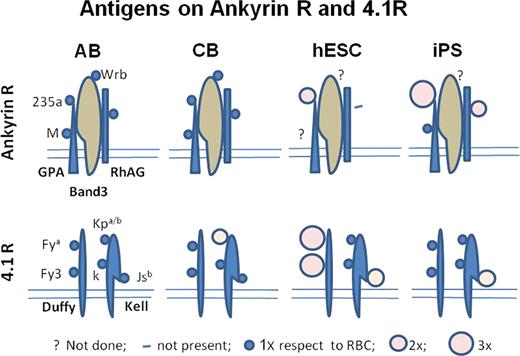Abstract
Abstract 1027
Red blood cells (RBC) survive shear forces in the microvasculature because trans-membrane complexes embedded in the lipid bilayer attach their membrane to the cytoskeleton assuring its flexibility. The expression of clinically relevant red blood cell antigens present on these complexes is determined by genetic polymorphisms and their developmental regulation. Therefore, flow cytometry studies of blood group antigens may provide insights both on potential immunogenicity and on membrane structure of ex-vivo generated EBs.
Blood group antigen profiles of EBs expanded ex vivo from one AB (three experiments), three CB, the H1 hESC line and one iPS line derived from mononuclear cells from a healthy donor were compared by flow cytometry using commercially available antibodies recognizing antigens present on proteins in the 4.1R [Duffy (Fya and Fy3), Kell (Kell prot, K/k, Kpa/Kpb, Jsb) and glycophorin C (GPC, Ge2)] and ankyrin R [glycophorin A (GPA, CD235a, M and EnaFS) RhAG and band 3 (Wrb)] complexes and on other important membrane proteins [glycophorin B (GPB, s and U), urea transporter (Kidd, Jk3), the complement receptor (CD35) and inhibitors of complement-mediated lysis (CD55 and CD59)]. Controls included DNA genotyping (CB, AB and H1-hESC) (HEA-Bead Chip, Immunocor, Norcross, GA) and immunophenotyping of blood red cells from the same AB and CB. Antigen expression similar to that observed on in vivo generated RBC was considered normal. EBs were generated from AB and CB at day 10 in HEMAser cultures whereas EBs from hESC and iPS were derived using previously optimized protocols. The maturation state was determined by morphological analyses and CD36/CD235a profiles.
Irrespective of the stem cell source, the immunophenotype of ex-vivo expanded EBs was consistent with that predicted by genotyping. However, source specific differences in the magnitude of antigen expression and in the changes with maturation were observed (see Figure). Immature EBs from AB expressed normal levels of the antigens present on both the 4.1R (Duffy, Kell, GPC) and ankyrin R (GPA, M/N, EnaFS, RhAG and band 3) complexes.
With maturation, expression of 4.1R-associated antigens remained normal while that of ankyrin R associated antigens varied (M decreased and RhAG increased). EBs from CB expressed normal levels of antigens present on the ankyrin R complex and of some of those present on the 4.1R complex (Duffy, Kell protein and GPA). However, expression of epitopes on Kell protein varied with some antigens expressed at normal levels (k and Jsb) and others (Kpa/Kpb) at levels 2x greater than normal. With maturation, CB-derived EBs maintained normal levels of ankyrin R associated antigens while those associated with complex 4.1R became barely detectable. EB from hESC expressed unbalanced levels of proteins associated with both ankyrin R (2x levels of GPA and barely detectable levels of RhAG) and 4.1R [3x levels of Duffy and 2x levels of Jsb (Kell) with normal levels of k and Kpb (Kell) antigens] complexes. The variegation in expression of different epitopes on the same protein observed with CB- and hESC-derived EBs likely reflect altered structural conformation of the complexes rather than differences in protein concentration on the membrane. EBs from iPS, as those from AB, expressed normal levels of antigens present on Ankyrin R and 4.1R complexes which increased with maturation.
Irrespective of stem cell sources, EBs expressed normal levels of GPB and Kidd. EBs from AB expressed normal levels of the complement regulatory proteins tested which in the case of CD59 CD59 decreased with maturation. EBs from CB expressed normal levels of CD35 and CD59 but 2x levels of CD55 with expression of CD35 and CD55 decreasing with maturation. EBs from iPS expressed 2x levels of CD35 and CD55 and expression of these antigens was not affected by maturation.
No relevant conflicts of interest to declare.
Author notes
Asterisk with author names denotes non-ASH members.


This feature is available to Subscribers Only
Sign In or Create an Account Close Modal